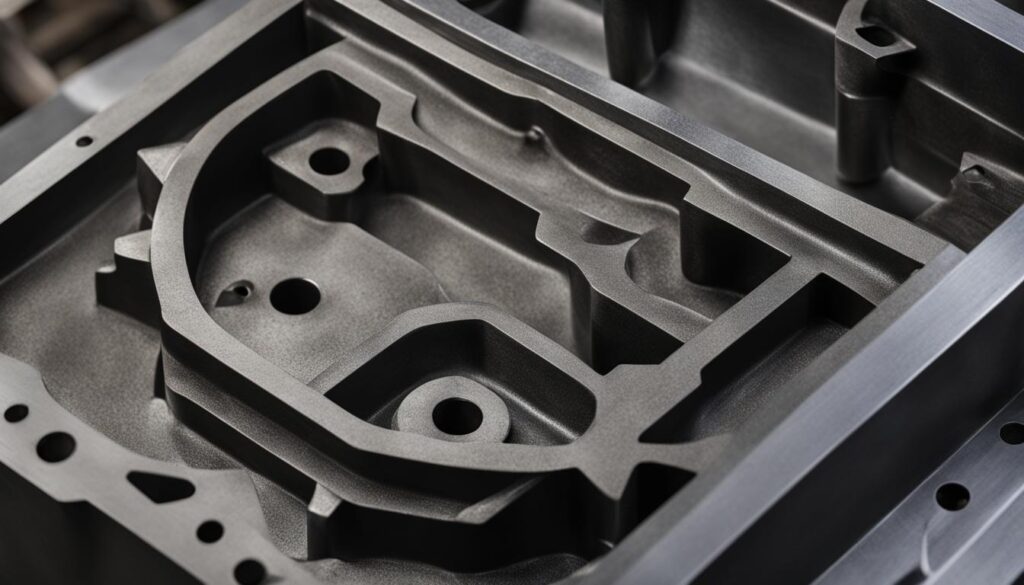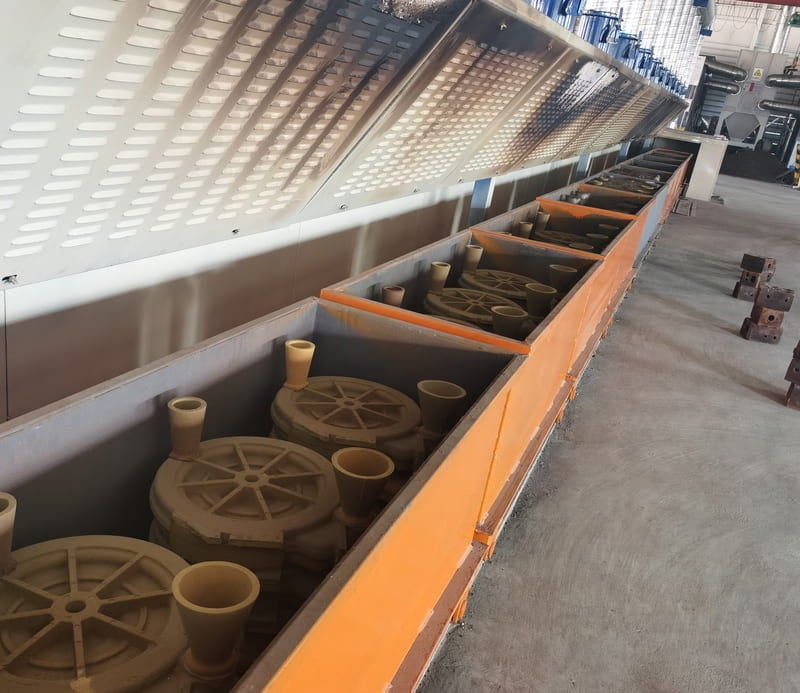When it comes to manufacturing automotive components and engine parts, carbon steel casting is a top choice in the industry. Its cost-effectiveness, wear resistance, and machinability make it an ideal material option for various applications. At our company, we specialize in carbon steel casting and offer a range of services to meet the specific requirements of the automotive sector.
The composition of carbon steel, which includes varying levels of carbon content, allows for its versatility in automotive manufacturing. Low carbon steel is commonly used for brackets, casings, and links, while medium carbon steel is ideal for levers, air-frame parts, and hydraulic machinery. High carbon steel, known as carbon tool steel, is the go-to option for high tensile applications like cranks and pins. Regardless of the application, carbon steel casting provides cost-effective mechanical parts, multiple material grades to fit any need, end-of-life recyclability, and high structural integrity.
Key Takeaways:
- Carbon steel casting is a preferred choice in the automotive industry for its cost-effectiveness and durability.
- Different grades of carbon steel are used for various automotive applications, ensuring optimal performance.
- Carbon steel casting offers a wide range of applications in the automotive sector, including engine parts and components.
- Companies specializing in carbon steel casting, like ours, can provide precise and high-quality castings for automotive manufacturers.
- Carbon steel casting ensures the strength and reliability required in the automotive industry.
Types of Carbon Steel in Casting
Carbon steel for casting can be categorized into three types based on the carbon content: low carbon steel, medium carbon steel, and high carbon steel. Each type offers distinct properties and is suitable for different applications within the automotive industry.
Low Carbon Steel
Low carbon steel contains a carbon content of 0.05% to 0.25%. It is commonly used for engineering steels in low and medium-strength applications. The low carbon content provides excellent weldability and formability, making it suitable for automotive components such as brackets, casings, and links. Despite its low carbon content, low carbon steel still offers sufficient strength and durability.
Medium Carbon Steel
Medium carbon steel has a carbon content of 0.29% to 0.54%. This type of carbon steel offers good shock and fatigue strengths, making it ideal for various automotive parts. It provides an excellent balance between strength and ductility, allowing it to withstand the demanding conditions of automotive applications. Medium carbon steel is commonly used for levers, air-frame parts, and hydraulic machinery.
High Carbon Steel
High carbon steel contains a carbon content of 0.55% to 0.95%. It provides high tensile strength, wear resistance, and hardness, making it suitable for heavy-duty applications in the automotive industry. High carbon steel, also known as carbon tool steel, is commonly used for components such as cranks, pins, and other high-tensile parts that require exceptional strength and durability.
The choice of carbon steel type depends on the specific requirements of the automotive component, considering factors such as strength, durability, and cost-effectiveness. By understanding the different types of carbon steel in casting, manufacturers can select the most suitable material for their applications, ensuring optimal performance and longevity.

“The composition of carbon steel, which includes varying levels of carbon content, makes it suitable for different automotive applications.” – Carbon Steel Expert
| Carbon Steel Type | Carbon Content (%) | Typical Applications |
|---|---|---|
| Low Carbon Steel | 0.05% – 0.25% | Brackets, casings, links |
| Medium Carbon Steel | 0.29% – 0.54% | Levers, air-frame parts, hydraulic machinery |
| High Carbon Steel | 0.55% – 0.95% | Cranks, pins, high-tensile parts |
Benefits and Applications of Carbon Steel Casting
Carbon steel casting offers a range of benefits that make it a preferred choice in the automotive industry. One of the main advantages is its cost-effectiveness. Compared to stainless steel, carbon steel is more affordable while still providing excellent durability. This makes it an attractive option for manufacturers looking to optimize costs without compromising on quality.
The wide range of applications is another key advantage of carbon steel casting. It is used in various automotive components such as fasteners, bolts, shafts, rods, and assemblies. Carbon steel’s ferromagnetic properties also make it particularly useful for motor and electrical appliances in the automotive industry. This versatility allows manufacturers to utilize carbon steel casting in multiple areas of their production processes, enhancing efficiency and reliability.
Carbon steel casting provides high structural integrity, ensuring safety and durability in automotive applications.
Furthermore, carbon steel casting offers exceptional structural integrity. This means that components produced through the casting process are strong and reliable, able to withstand demanding conditions. The high tensile strength, wear resistance, and hardness of carbon steel make it ideal for heavy-duty applications in the automotive industry. This ensures that the manufactured parts maintain their performance and longevity, enhancing the overall quality of vehicles.
Examples of Applications:
- Fasteners and bolts
- Shafts and rods
- Brackets and casings
- Motor and electrical appliances
- Hydraulic machinery
| Benefits | Applications |
|---|---|
| Cost-effective | Fasteners, bolts |
| Wide applications | Shafts, rods |
| Ferromagnetic properties | Motor, electrical appliances |
| Structural integrity | Brackets, casings |
Carbon Steel Casting Process and Products
Carbon steel casting is a versatile process that utilizes different casting methods to produce a wide range of products for various applications in the automotive industry. Silica Sol Casting and Water Glass Casting are two commonly used processes for carbon steel casting.
Silica Sol Casting
Silica Sol Casting, also known as lost wax casting, is a precise and high-quality casting process used for carbon steel. It involves creating a wax pattern of the desired part, which is then coated in a ceramic shell. The wax is melted out, leaving behind a hollow mold. Molten carbon steel is then poured into the mold, filling the cavity. Once the steel solidifies, the ceramic shell is broken to reveal the final carbon steel casting. This process ensures excellent surface finish, tight tolerances, and intricate details in the final product.
Water Glass Casting
Water Glass Casting, also known as sodium silicate casting, is a cost-effective method used for producing carbon steel castings. In this process, a mixture of silica sand and sodium silicate is used to create molds. The mixture is poured around a wax pattern, which is later melted and drained, leaving behind a cavity in the mold. Molten carbon steel is then poured into the mold and allowed to solidify. The mold is broken to extract the carbon steel casting. While Water Glass Casting may not provide the same level of precision and surface finish as Silica Sol Casting, it offers a more economical solution for certain applications.
Carbon steel castings produced through these processes can be customized to meet specific material compositions and standards. Different grades of carbon steel, such as AISI 1010, AISI 1020, AISI 1035, AISI 1045, and AISI 1060, can be used to create automotive components and engine parts with varying mechanical properties. Secondary operations like machining, non-destructive testing, heat treatment, and assembly can also be performed on carbon steel castings to meet specific requirements.
| Process | Advantages | Disadvantages |
|---|---|---|
| Silica Sol Casting | Precise castings, high surface finish, tight tolerances, intricate details | Higher cost compared to Water Glass Casting |
| Water Glass Casting | Cost-effective, suitable for larger and less complex parts | Lower precision and surface finish compared to Silica Sol Casting |

Both Silica Sol Casting and Water Glass Casting play important roles in the production of carbon steel castings, each with its own advantages and considerations. The choice of casting process depends on the specific requirements of the automotive component or engine part, including the desired level of precision, surface finish, and cost-effectiveness. By utilizing these casting processes, manufacturers can produce high-quality carbon steel castings that meet the demanding standards of the automotive industry.
Conclusion
Carbon steel casting has emerged as a vital component in the automotive industry, showcasing superior performance and unparalleled durability. Its cost-effectiveness, coupled with a wide range of applications and high structural integrity, positions it as the ideal choice for automotive components and engine parts.
By utilizing different grades of carbon steel and employing advanced casting processes like Silica Sol Casting and Water Glass Casting, automotive manufacturers can achieve precise and high-quality castings that meet the stringent demands of the industry. At KT-Foundry, we specialize in carbon steel casting and offer a comprehensive range of services tailored to the specific requirements of the automotive sector.
With our expertise, we can provide not only the strength and reliability needed for fasteners, brackets, and complex engine components but also the assurance of delivering top-notch performance and longevity. As the automotive industry continues to evolve, carbon steel casting will remain a cornerstone, ensuring the production of durable and efficient vehicles.
FAQ
What are the benefits of using carbon steel casting in the automotive industry?
Carbon steel casting offers cost-effectiveness, multiple material grades, recyclability, and high structural integrity.
What are the different types of carbon steel used in casting?
Carbon steel can be categorized into low carbon steel, medium carbon steel, and high carbon steel.
Where is carbon steel casting commonly used in automotive applications?
Carbon steel casting is commonly used for automotive components such as fasteners, bolts, shafts, rods, and assemblies.
What casting processes can be used to produce carbon steel castings?
Silica Sol Casting (lost wax casting) and Water Glass Casting are two commonly used casting processes for carbon steel casting.
What grades of carbon steel can be produced through investment casting?
Our company, KT-Foundry, can produce carbon steel castings in various grades such as AISI 1010, AISI 1020, AISI 1035, AISI 1045, AISI 1060, and more.


